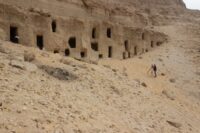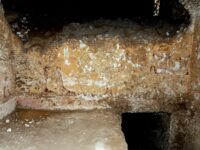 A group of 250 rock-cut tombs have been discovered in the Al-Hamidiyah necropolis near Sohag on the western bank of the Nile in southern Egypt. They were found in the course of a Supreme Council of Antiquities project to document the archaeological site.
A group of 250 rock-cut tombs have been discovered in the Al-Hamidiyah necropolis near Sohag on the western bank of the Nile in southern Egypt. They were found in the course of a Supreme Council of Antiquities project to document the archaeological site.
Tombs of different types — single and multiple shaft burials, chamber graves — were carved into the face of the mountain at various levels. The  range in date from the late Old Kingdom (2700-2200 B.C.) to the end of the Ptolemaic era (305-30 B.C.). Most of the extant ancient archaeological remains near Sohag are Ptolemaic, so the Old Kingdom tombs are particularly notable.
range in date from the late Old Kingdom (2700-2200 B.C.) to the end of the Ptolemaic era (305-30 B.C.). Most of the extant ancient archaeological remains near Sohag are Ptolemaic, so the Old Kingdom tombs are particularly notable.
One of the Old Kingdom tombs uncovered consists of an entrance leading to a cross-hall and a burial shaft in the south-east side, and a sloped passage leading to a small burial chamber, Waziri said, with burial shafts making an appearance in later eras.
Waziri explained that the tomb also featured a false door covered in Hieroglyphic inscriptions, alongside depictions of sacrifices and offerings to the dead.
 Excavation of the tombs has unearthed funerary artifacts, primarily pottery, some of which were items of daily use. Others were purely funerary, votive miniatures explicitly made for burial purposes. The team also discovered spherical pots with traces of their original yellow paint, small alabaster vessels and a round metal mirror. In addition to the inscribed false door from the Old Kingdom tomb, archaeologists uncovered fragments of limestone slabs carved with hieroglyphics dating to the end of the 6th Dynasty.
Excavation of the tombs has unearthed funerary artifacts, primarily pottery, some of which were items of daily use. Others were purely funerary, votive miniatures explicitly made for burial purposes. The team also discovered spherical pots with traces of their original yellow paint, small alabaster vessels and a round metal mirror. In addition to the inscribed false door from the Old Kingdom tomb, archaeologists uncovered fragments of limestone slabs carved with hieroglyphics dating to the end of the 6th Dynasty.
This group of tombs represents the rulers and employees of the ninth region of Upper Egypt, which is considered one of the important administrative centres of ancient Egypt, due to the location of the Mediterranean between the exiled capital and Aswan, as well as the vicinity of the city of Abydos, which is the centre of the worship of the god ‘Osir’.
The main centre of the region was the city of Akhmim, and the main deity of the region was the god ‘Min’. It is expected that more graves will be uncovered before the project is completed.
Reminds me of the caves in Matala (southern Crete):
The artificial caves in the cliff of the Matala bay were created in the Neolithic. Matala was the port of Phaistos during the Minoan period.
In 220 BC, Matala was occupied by the Gortynians, and during the Roman period, when the caves were used as graves(!), the bay became the port of Gortys. In 1960s, the caves were occupied by hippies, lots of them from the US, escaping Vietnam.
Fun fact:
When I was there (a decade ago), on a beach a few km to the West, one of the locals told me that the “US army” had been “training for the occupation of Vietnam”, notably by attacking the “Paximadia” islands 15km off shore, which he could observe from his terrace.
:hattip:
—–
commons.wikimedia.org/wiki/Category:Caves_of_Matala
en.wikipedia.org/wiki/Paximadia
Speaking of Crete and other historical events associated with it, today marks 80 years since the German airborne assault against the island.
Albert, I was of course fully aware of the fact, but NOT of its 80th –well– “anniversary”.
Unfortunately, my own grandpa was himself active in attacks back then on behalf of the Germans –or at least their government– but he was shot [down?] in March 1945 and he died on “March 26th of shrapnel to stomach and head at 3:50 PM”, according to a report.
About my “Luftwaffe” grandpa I hardly knew anything, other than he died near Gdansk and is buried there, until two years ago, I received a hard-copy of somebody reporting in 1951 about the incidents of 1945. Apparently, there were plans for an “aircraft carrier” that were given up (his unit might have been involved, it’s confusing and I know too little).
Also, I received another hard-copy of a report from July 1941 that he was shot down in Russia, but had made it back after 18 hours alive, but the pilot died in the crash. The “war report” is cryptic, as the location is given as a village “M.”. The report also indicates that they had been plans to use this for propaganda, but I am unaware of any “official” reports.
In that war report from 1941, it clearly reads “Verteilerwunsch” –i.e. “best distributed to”– “National-Zeitung Essen” and “Frankfurter Oderzeitung”, i.e. already at the front, they planned in which newspapers certain issues were to be published.
As far as Crete is concerned, he seems to have an alibi.
🙁
—–
Notably, my other(!) grandpa had been sent to the front, until –in hindsight– in a brilliant move, he turned home, in order to become an engineer and, thence, to diffuse ca. 250 unexploded allied bombs from 1941-44 in the Berlin area. I am in possession of his original log files from 1941-44, with full data sets (addresses, loads, types etc.).
Joni, Look up the aircraft carrier Graf Zepplin, the only carrier the Germans built during WW2. It never became operational but IIRC the Soviets took it over at the end of the war, possibly at Gdansk. Your grandfather may have been assigned to the Luftwaffe contingent associated to the ship.
Thanks, George.
As far as I could tell, the ‘Graf Zepellin’ was their one and only aircraft carrier, and I had already found out about it. On the other hand, I really have no idea, when and under which circumstances he joined the club.
So far, I had been under the impression that he was “made a pilot” just shortly before the end. When I found that war report about their crash of 1941 behind enemy lines, however, I searched for the “Stuka 2/186, Nr..” –allegedly his identification tag in 1945– and to my surprise I then found about that aircraft carrier.
What makes it even more complicated, is that there seem to have been a few reorganizations. According to that letter from 1951, he was –exactly like my other grandpa– born in 1917, in his case in January. In 1937 he would have been 20.
:hattip:
————-
PS: According to the “Iliad” in II.645-652, Southern Cretans from the Matala/ Phaistos and Gortyna area –and others– took part in the ‘Trojan War’, i.e. those Cretans sent “eighty black ships”:
—
Κρητῶν δ’ Ἰδομενεὺς δουρὶ κλυτὸς ἡγεμόνευεν,
οἳ Κνωσόν τ’ εἶχον Γόρτυνά τε τειχιόεσσαν,
Λύκτον Μίλητόν τε καὶ ἀργινόεντα Λύκαστον
Φαιστόν τε Ῥύτιόν τε, πόλεις εὖ ναιετοώσας,
ἄλλοι θ’ οἳ Κρήτην ἑκατόμπολιν ἀμφενέμοντο.
τῶν μὲν ἄρ’ Ἰδομενεὺς δουρὶ κλυτὸς ἡγεμόνευε
Μηριόνης τ’ ἀτάλαντος Ἐνυαλίῳ ἀνδρειφόντῃ·
τοῖσι δ’ ἅμ’ ὀγδώκοντα μέλαιναι νῆες ἕποντο.
—
Here a picture from the beach (NOT in Matala/ Matalia), where I was informed about Vietnam, with another local, the Lybian Sea and either my towel or shirt and above that, fuzzy in the background, the ‘Paximadia’ islands.
i.imgur.com/dsWUKpr.jpg
The camera I got from A*** in 2005 for 140EUR, with special “features”, e.g. a program for ‘Collections’ (applied here). Unfortunately, the mechanic is dead now, and I have to cope with an entirely useless free Casio :no: